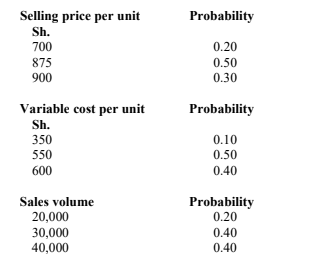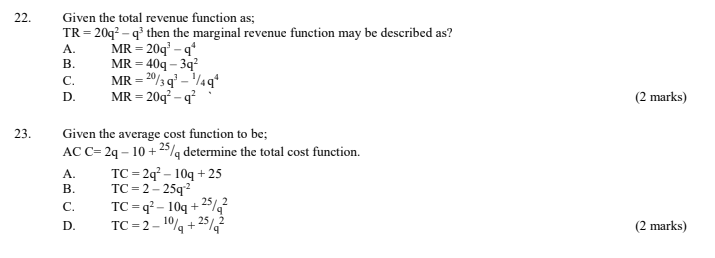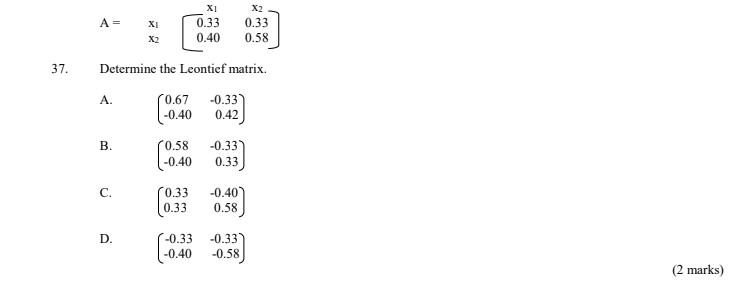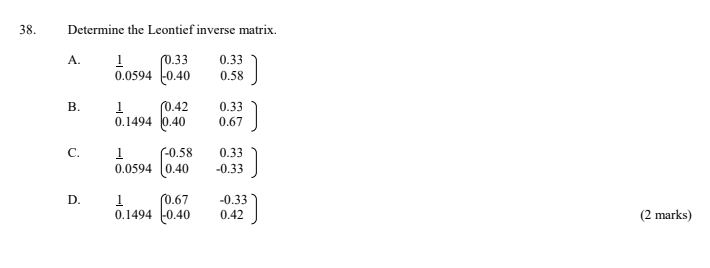TUESDAY: 2 August 2022. Afternoon paper. Time Allowed: 2 hours.
This paper is made of fifty (50) Multiple Choice Questions. Answer ALL questions by indicating the letter (A, B, C or D) that represents the correct answer. Each question is allocated two (2) marks.
1. The following are methods used in the determination of the regression line. Which one is the most superior of all?
A. High-low method
B. Ordinary least method
C. Semi averages method
D. Method of inspection (2 marks)
2. What is the name given to the estimation that is based on values of the independent variable in a region that has not been considered in the calculation of the appropriate regression line?
A. Extrapolation
B. Interpolation
C. Prediction
D. Forecasting (2 marks)
3. From the following bivariate data, which one would you expect to be negatively correlated?
A. Number of calls made by a salesman and number of sales obtained
B. Age of insured person and amount of premium
C. Number of weeks of experience and number of errors made
D. Number of vehicles licenced and road deaths (2 marks)
4. The coefficient of determination between turnover (y) measured against advertising expenditure (x) is given as 0.58.
Calculate the coefficient of correlation.
A. 0.34
B. 0.76
C. 0.66
D. 0.24 (2 marks)
5. The variation between individual y values and their mean is known as?
A. Total variation
B. Explained variation
C. Unexplained variation
D. Error term (2 marks)
![]() 6.
6.
What is the correlation coefficient?
A. 1
B. 0.25
C. -1
D. 0.75 (2 marks)
7. Using the data in Question 6 above, compute the value of b for the linear regression line.
y = a + bx
A. 1.5
B. 0.76
C. 0.67
D. -1.5 (2 marks)
8. Using the data in Question 6 above, compute the value of a for the linear regression line;
y = a + bx
A. 8
B. -6
C. 21
D. 192 (2 marks)
9. ____________is used to indicate the proportion of the total variation in the independent variable (y) that is due to variation in the independent variable (x).
A. Product moment correlation
B. Rank correlation coefficient
C. Standard error of estimate
D. Coefficient of determination (2 marks)
10. Correlation observed between two variables that are not conceivably causally related is called?
A. Non-sense correlation
B. Weak correlation
C. Negative correlation
D. Positive correlation (2 marks)
Use the following information to answer question 11 to 15.
Vesto Ltd. intends to launch a new product into the market. The following information relates to the possible values of selling price, variable cost and annual sales from the product:

11. What is the expected value of demand?
A. 20,000
B. 30,000
C. 32,000
D. 40,000 (2 marks)
12. What is the expected value of unit selling price?
A. 847.5
B. 825
C. 875
D. 900 (2 marks)
13. What is the expected value of the unit variable cost?
A. 500
B. 600
C. 350
D. 550 (2 marks)
14. What is the expected contribution?
A. 9,750,000
B. 9,520,000
C. 12,000,000
D. 15,750,000 (2 marks)
15. Given random numbers of 80, 60 and 43, determine the contribution for the first run.
A. 7,425,000
B. 8,250,000
C. 10,500,000
D. 9,000,000 (2 marks)
Use the following information to answer question 16 to 19.
A normal distribution of students’ grade points has a mean of 2.75 and standard of 0.40.
16. The probability of a score of between 2.00 and 3.00 is approximately?
A. 0.2342
B. 0.2357
C. 0.7056
D. 0.4699 (2 marks)
17. The probability of a score greater than 3.00 is approximately?
A. 0.2357
B. 0.7643
C. 0.2643
D. 0.7357 (2 marks)
18. The probability is a score greater than 2.00 is approximately?
A. 0.9699
B. 0.4699
C. 0.5301
D. 0.0301 (2 marks)
19. Assuming that the total number of students is 1,000, determine the number of students having a grade point of 3.70 or higher.
A. 509
B. 491
C. 9
D. 991 (2 marks)
Use the data below to answer question 20 and 21.
The data below relates to results of a regression run on the variations on overhead cost as a function of the number of components produced:

20. Determine the estimated regression model.
A. y = 22 + 0.01001x
B. y = 1 + 0.029x
C. y = 0.077 + 0.826x
D. y = 0.0068 + 0.103x (2 marks)
21. Compute the explanatory power of the model.
A. 0.275
B. 0.043
C. 0.96
D. 0.725 (2 marks)

24. Probabilities models are also known as?
A. Dynamic models
B. Deterministic models
C. Stochastic models
D. Static models (2 marks)
25. A linear programming problem which can be improved without limit is said to be?
A. Infeasible
B. Alternate
C. Unbounded
D. None of the above (2 marks)
26. A linear programming problem which does not satisfy all the constraints simultaneously is said to be?
A. Unbounded
B. Infeasible
C. Non-optimal solution
D. Optimal solution (2 marks)
27. A linear programming problem is based on the following assumptions EXCEPT?
A. Certainty
B. Divisibility
C. Proportionality
D. Continuity (2 marks)
28. In linear programming, a constraint which does not determine the feasible region is said to be?
A. Redundant constraint
B. Binding constraint
C. Non-binding constraint
D. Surplus constraint (2 marks)
29. The graphical method may be used to solve linear programming problems with _______variables.
A. More than two
B. Two
C. Three
D. Any number of (2 marks)
30. If there is more than one optimal solution to a linear programming problem, then the solution is?
A. Unbounded
B. Feasible
C. Infeasible
D. Alternate (2 marks)
31. The goal of the linear programming problem expressed in mathematical form is known as?
A. Decision variable
B. Objective function
C. Goal function
D. Constraints (2 marks)
32. In linear programing, alternative choices available for the researcher to choose from are known as?
A. Alternative solutions
B. Objective coefficient
C. Constraints
D. Decision variables (2 marks)
33. An assumption in linear programming that implies that solutions to linear programming problems need not to be integer is known as?
A. Additivity
B. Certainty
C. Divisibility
D. Non-negativity (2 marks)

35. _____________________ is the imitation of the operation of areal world process over time.
A. Modelling
B. Simulation
C. Controlling
D. Copying (2 marks)
36. Which of the following are the advantages of simulation
A. Flexibility
B. Helps study impact of different variables
C. Easy to test
D. All of the above (2 marks)
Use the following data to answer question 37, 38 and 39.
The matrix of Technical coefficient for a small two sector economy is provided below as follows:



40. The matrix of technical coefficient is also called?
A. Transition matrix
B. Technological matrix
C. Leontief Matrix
D. Leontief inverse matrix (2 marks)
41. The sum of the difference between the actual value y and the predicted value y expressed as squares is called the?
A. Total sum of squares
B. Residual sum of squares
C. Regression sum of squares
D. Explained variation (2 marks)
42. The relevant range for the coefficient of determination must be?
A. Between -1 and + 1
B. Between 0 and 1
C. Between -1 and 0
D. None of the above (2 marks)
43. For the regression equation; y = 3.5 – 2.3x the slope is?
A. 3.5
B. -2.3
C. -3.5
D. 2.3 (2 marks)
44. In the regression model; y = 0.32 + 1.64x the intercept is?
A. -0.32
B. 1.64
C. 0.32
D. -1.64 2 marks)
45. The square root of the average deviation of actual value and the predicted values expressed as squares is called?
A. Coefficient of determination
B. Standard error of estimate
C. Error sum of squares
D. Residual (2 marks)
46. For a given regression equation; y + 29 – 0.28x the correlation coefficient for the data.
A. Is negative
B. Is positive
C. Is zero
D. Must be one (1) (2 marks)
A regression analysis is carried out on y and s independents variables.
Number of observation = 20
Total sum of squares = 500
Sum of squared errors = 200
Use the above information to answer questions 47 and 48.
47. What is the degree of freedom for the total sum of squares?
A. 16
B. 19
C. 18
D. 5 (2 marks)
48. What is the degree of freedom for the error sum of squares?
A. 19
B. 14
C. 16
D. 4 (2 marks)
The data below is used to construct a regression model:

Use the data to answer questions 49 and 50.
49. The value of a is?
A. 6
B. -1.8
C. 3
D. 5 (2 marks)
50. The value of y when x is 10 is?
A. 6.2
B. 7.25
C. 0.8
D. 50 (2 marks)